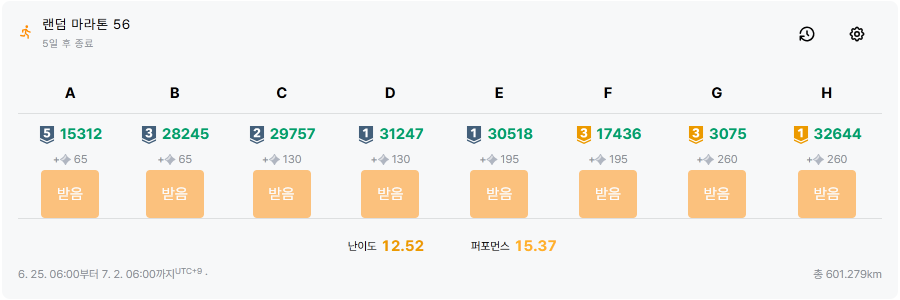
A. 이름 궁합
 실버 V
실버 V
길이 두배의 배열을 만들어서 인덱스 기준 짝수번째 위치(i « 1)에 a를, 홀수번째 위치(i « 1 | 1)에 b를 배치한 다음 문제에서 요구하는 대로 인접한 것들끼리 합해주면 됩니다.
1 | |
B. 배고파(Hard)
 실버 III
실버 III
$m \le 10^{18} < 2^{60}$이므로 브루트 포스를 이용해 시간 복잡도 $O(60^2N)$에 해결할 수 있습니다.
1 | |
C. 트리 긋기
 실버 II
실버 II
x좌표가 같은 점들끼리 세로로 연결하고, 나머지 점들은 각 x좌표마다 y좌표가 가장 작은 점들끼리만 이어주면 됩니다.
1 | |
D. 2024는 무엇이 특별할까?
 실버 I
실버 I
$K = 0$인 경우에 대해 생각해 봅시다. 약수 중 짝수인 것의 개수가 $0$이어야 하므로 소인수로 $2$를 갖지 않아야 함을 알 수 있습니다.
$K = 1$인 경우에 대해 생각해 봅시다. 홀수 $p$에 대해 $n = 2p$인 경우를 생각해 봅시다. 홀수인 약수의 개수는 $p$의 약수의 개수와 같습니다. 짝수인 약수는 홀수인 약수에 $2$를 곱한 것과 같으므로 $p$의 약수에 $2$을 곱한 것과 같습니다. 따라서 $\tau_e(n) = \tau_o(n)$입니다.
$K = 2$인 경우에 대해 생각해 봅시다. 홀수 $p$에 대해 $n = 2^2p$라면 홀수의 약수에 $2$를 곱한 것과 $2^2$를 곱한 것이 짝수인 약수가 되므로 $\tau_e(n) = 2\tau_o(n)$입니다.
일반화하여 $n = 2^Kp$라면 $\tau_e(n) = K\tau_o(n)$입니다. 따라서 $2^Kp \le N$을 만족하는 홀수 $p$의 개수가 정답입니다.
1 | |
E. 짜고 치는 가위바위보 (Small)
 실버 I
실버 I
가능한 모든 경우를 테스트 해 보면 됩니다. 부분 집합은 비트마스킹으로 표현할 수도 있고, 백트래킹으로 구할 수도 있습니다.
1 | |
F. 소수의 배수
 골드 III
골드 III
포함 배제의 원리를 이용해 풀 수 있습니다.
각 소수의 배수를 한 번씩 모두 셉니다. 그렇다면 두 소수가 곱해진 것들은 두 번 세어지므로($ab = ba$) 두 소수의 곱의 배수를 배제합니다. 그렇다면 세 소수가 곱해진 것들은 두 번 배제되므로($(ab)c = c(ab)$) 다시 한 번씩 세어줍니다. 반복하여 홀수번 곱해진 경우는 세고, 짝수번 곱해진 경우는 배제합니다.
1 | |
G. Astromeeting
 골드 III
골드 III
모든 정점마다 한 번씩 비용의 합을 계산해 보면 됩니다. 저는 시간 초과를 우려하여 데이크스트라를 이용해 풀었는데, 플로이드-워셜로도 풀린다고 합니다.
1 | |
G. 랜덤 넘버 추측하기
 골드 I
골드 I
어느 시점에서 $i$번의 응모권을 개수를 $a_i$라 합시다. $k$번을 뽑으려면 랜덤 넘버 $X$는 아래를 만족해야 합니다.
\[\left(\sum^{k-1}_{i = 1}a_i\right) < X \le \left(\sum^{k}_{i = 1}a_i\right)\]랜덤 넘버는 위 식을 만족하는 값을 아무거나 출력하면 되고, 그 때 $k$번의 응모권 개수 $a_k$를 $0$으로 만들어 주면 됩니다. 배열의 값이 변하는 구간 합은 세그먼트 트리를 이용해서 $O(\log N)$에 해결할 수 있습니다.
아래 코드에서는 $k - 1$이 인덱스를 벗어나는 것을 우려하여 $k$까지의 구간합을 출력했습니다.
1 | |